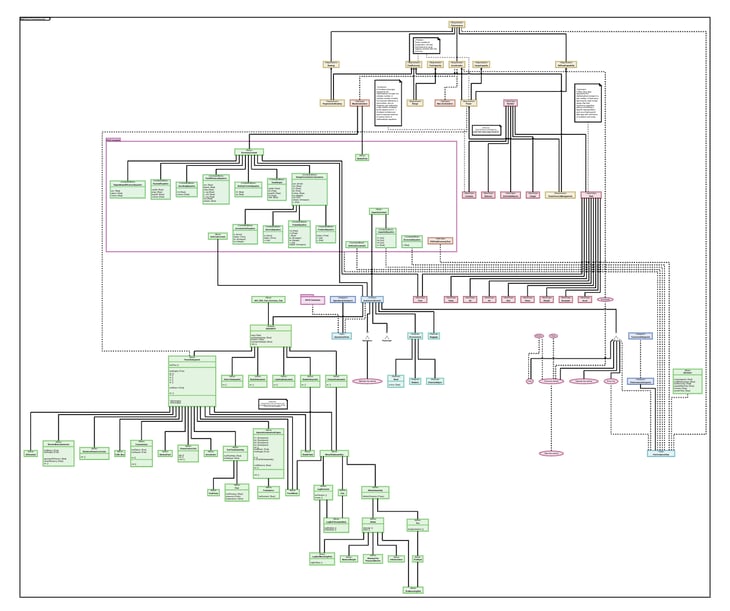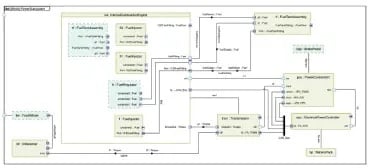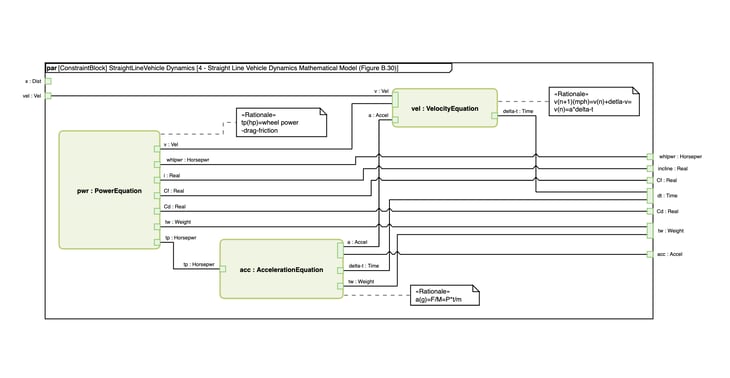What are MBSE tools?
MBSE tools are software applications or suites designed to support the model-based systems engineering methodology. They facilitate the creation, analysis, and management of the system models that form the core of Model Based System Engineering. These models are graphical representations of systems, showing components, relationships, behaviors, and constraints.
The primary significance of these engineering tools lies in their ability to provide a clear and shared understanding of the system under development. They aid in visualizing complex interactions and dependencies, thereby reducing errors and inconsistencies that often arise in large-scale projects.

Complex MBSE model automatically visualized with Tom Sawyer Perspectives.
Exploring the Essentials of MBSE Tools
Model-Based Systems Engineering tools represent a paradigm shift in how engineers and project managers approach system development. These tools are not merely software solutions but comprehensive platforms that transform abstract concepts into tangible models, facilitating a clearer understanding of complex systems. MBSE tools serve as the backbone for effectively managing the intricacies of systems engineering, encompassing a range of functionalities from conceptual design to simulation and analysis.
The essence of MBSE lies in its ability to create a cohesive and interconnected model of a system. This holistic approach, powered by advanced MBSE software, ensures that all components of a system are considered in relation to each other, promoting a more integrated and efficient design process. By leveraging these tools, engineers can visualize complex interactions, predict potential issues, and make informed decisions based on robust data-driven insights.
Defining the Core Components of MBSE Tools
The Role of Visual Modeling
Visual modeling stands at the forefront of what makes MBSE tools indispensable in systems engineering. These tools enable the creation of detailed, graphical representations of complex systems, offering an intuitive understanding that textual descriptions alone cannot provide. Through visual modeling, MBSE software allows engineers to see the big picture and the minute details, ensuring that every aspect of the system is accurately represented and understood.
This capability is particularly beneficial in identifying potential design conflicts early, streamlining the development process, and facilitating more effective communication among stakeholders. Translating intricate system interactions into clear visual formats breaks down the complexity barrier, making systems engineering more accessible and comprehensible.
Integrating Diverse Data in MBSE Tools
Data integration is another cornerstone of MBSE tools. The ability to seamlessly incorporate data from various sources into a unified model is what sets advanced MBSE software apart. This integration enables a comprehensive view of the system, ensuring that all decisions are made with the most complete and current information available.
MBSE tools adeptly handle diverse data types – from performance metrics to design parameters – and synthesize them into cohesive models. This integration not only enhances accuracy but also fosters a more collaborative and informed decision-making process.

Tom Sawyer Model-Based Engineering provides nested drawings to support complex MBSE models.
The Importance of Interactive Diagrams in MBSE Tools
Interactive diagrams are a vital feature of MBSE tools, offering an engaging way to explore and manipulate system models. These diagrams provide a dynamic interface where engineers can test scenarios, visualize outcomes, and understand the ramifications of changes in real time.
Tools that offer interactive, user-friendly diagramming capabilities significantly enhance the user experience. They make collaboration easier for teams, understanding complex systems, and achieving a shared vision. The interactivity of these diagrams in MBSE tools goes beyond mere visualization—it becomes a powerful tool for experimentation, innovation, and discovery in systems engineering.
Advanced Features of Modern MBSE Tools
Enhancing Efficiency with Automated Layouts
One of the standout advancements in modern MBSE tools is the implementation of automated layouts. These layouts are crucial in managing the complexity of system models, offering a streamlined and efficient way to organize and display vast amounts of information. Automated layouts in tools adapt dynamically to changes in the system, maintaining clarity and coherence even as the model evolves.
This feature is especially beneficial in large-scale projects where manual organization of elements can be time-consuming and error-prone. Automated layouts not only save time but also enhance the accuracy and readability of the models. They ensure that engineers can focus on design and analysis rather than getting bogged down by the logistics of model organization.
The Impact of Real-time Analysis and Simulation in MBSE Tools
Real-time analysis and simulation in MBSE tools have revolutionized the way engineers approach system design and validation. These features allow for the testing of different scenarios and conditions, providing insights into how the system might behave under various circumstances. This capability is invaluable for identifying potential issues, optimizing system performance, and making informed decisions.
Those tools offer advanced real-time analysis and simulation capabilities, enabling engineers to conduct thorough evaluations of their models. This feature not only saves time and resources but significantly reduces the risks associated with system development by allowing for preemptive adjustments and improvements.

Real-time analysis of systems models reduce risks and allow for adjustments and improvements.
Customization and Flexibility: Tailoring Tools to Specific Project Needs
Customization and flexibility are key characteristics of advanced MBSE tools, allowing them to be tailored to the specific needs of different projects and industries. These tools provide customizable interfaces, model templates, and functionality that can be adapted to suit a wide range of applications. This adaptability ensures that the tool remains relevant and effective across various engineering disciplines and project types.
Tom Sawyer Software’s app exemplifies this flexibility, offering extensive customization options that cater to the unique requirements of each project. Whether it's adapting the tool for aerospace engineering, automotive design, or IT infrastructure modeling, the ability to customize ensures that the tool can effectively support the specific demands of each domain.
The Importance of Collaboration and Accessibility in MBSE Tools
Collaborative Features for Team-Based Projects
Collaboration is a critical component in the field of systems engineering, and modern MBSE tools are designed to facilitate this. These tools provide platforms for team members to work together seamlessly, regardless of their physical location. Features like shared model access, real-time editing, and version control are integral to fostering a collaborative environment.
In those engineering tools, collaborative features ensure that all stakeholders, from engineers to project managers, can contribute and stay updated on the project's progress. This collaborative approach not only streamlines the workflow but also enhances the quality of the system design, as it incorporates diverse options and expertise.
Web-Based Access and Cross-Platform Compatibility in MBSE Tools
The accessibility of MBSE tools is another crucial factor, particularly in today's global and mobile workforce. Web-based access and cross-platform compatibility are not just conveniences but necessities for effective systems engineering. These features enable team members to access and work on models from anywhere, using any device.
MBSE tools, which offer web-based interfaces and compatibility across different operating systems, break down geographical and technological barriers. This universal access ensures that teams can continue to work on their projects without interruptions, making the engineering process more flexible and responsive to changes.
Applications of MBSE Tools in Various Industries
MBSE tools have found applications across a wide range of industries, demonstrating their versatility and effectiveness in tackling complex systems. For instance, MBSE tools are used to model intricate aircraft systems, ensuring safety and efficiency. Automotive industry leaders rely on these tools for designing and testing new vehicle systems, where every component must interact flawlessly.
MBSE tools play a crucial role in streamlining operations and improving service delivery in sectors like healthcare and telecommunications. They allow for the creation of detailed models of networks and systems, providing insights that drive innovation and efficiency. These real-world applications showcase the adaptability and practicality of MBSE tools in addressing diverse industry-specific challenges.

An MBSE visualization of an electric vehicle with precise port placement.
Demonstrating the Impact of MBSE Tools through Real-World Examples
The impact of MBSE tools is further illuminated through specific case studies. For example, an automotive company may use MBSE tools to reduce the development time of a new car model, while an IT firm might employ these tools to optimize network infrastructure. Each case study demonstrates how MBSE tools can lead to tangible improvements, such as cost reduction, enhanced performance, and accelerated time-to-market.
These examples not only highlight the capabilities of MBSE tools but also underscore their value in real-world scenarios. By providing concrete evidence of their impact, these case studies serve as powerful testimonials to the efficacy of MBSE tools in various industrial contexts.
How an App Embodies the Ideal MBSE Tool
This high-standard engineering tool is a prime example of an advanced MBSE tool, embodying the essential features that make MBSE so impactful in systems engineering. Its sophisticated visual modeling capabilities allow for the creation of intricate and precise system representations, crucial for understanding and managing complex projects. Its ability to integrate various data sources into a cohesive model sets it apart, providing a comprehensive view of system interactions and dependencies.
Moreover, the tool's interactive diagrams offer an intuitive interface for exploring and modifying system models, a feature that enhances both the understanding and communication of complex systems. This level of interactivity is vital for collaborative design and decision-making processes, making this sophisticated software an invaluable asset in any systems engineering project.
Unique Value Proposition in Systems Engineering
Perspectives' unique value proposition lies in its versatility and depth. It caters to a wide range of engineering disciplines, from aerospace to IT infrastructure, offering tailored solutions that address specific industry challenges.
In analyzing the features of this tool, it's evident that it was designed with the needs of modern systems engineering in mind. Its automated layout capabilities significantly reduce the time and effort required to maintain complex models. The tool's direct access to the source model allows engineers to validate accuracy and consolidate various diagrams from different domains into a unified, dynamic, and interactive view that caters to the needs of specific end users.
The customization and flexibility that are offered in this engineering tool are also noteworthy. It can be tailored to meet the specific requirements of different industries and projects, demonstrating its versatility and user-centric design. This adaptability ensures that the tool remains relevant and effective, regardless of the complexity or scale of the project at hand.
Positioning Among Other MBSE Tools
When comparing MBSE tools, it's important to consider the spectrum of features and functionalities they offer. Key evaluation aspects include visual modeling capabilities, data integration efficiency, real-time analysis and simulation, and collaborative features. Each tool has its strengths and areas of specialization, catering to different needs and project requirements.
Compared to MBSE tools in the market, Perspectives distinctively stands out for its comprehensive and user-friendly features. This app excels in areas like automated diagram layout, data integration, and interactive navigation and filtering. These capabilities are not only advanced but also intuitively designed, making the tool accessible to both seasoned engineers and those new to MBSE.
The comparison with other tools reveals its ability to easily handle complex, multi-dimensional models, which sets a high standard in the field. This tool demonstrates a unique balance of power and usability, a combination that is critical in the fast-paced and ever-evolving landscape of systems engineering.
A Balanced Look at MBSE Tools: Features and Functionalities
A balanced examination of MBSE tools in the market shows a spectrum of capabilities and specializations. Some tools might prioritize specific aspects like simulation accuracy or data processing speed, while others focus on user experience and collaborative features. Some strike a harmonious balance in these areas, offering a well-rounded solution that addresses multiple aspects of systems engineering.
It's important to recognize that the choice of an MBSE tool often depends on the specific needs and context of a project. Factors like the scale of the project, industry requirements, and team dynamics play a significant role in determining the most suitable tool capable of adapting to a wide range of engineering challenges.
Trends and Innovations in Model-Based System Engineering Tools
The future of MBSE tools is shaped by continuous innovation and evolving industry needs. Emerging trends indicate a growing emphasis on AI integration, cloud-based collaboration, and enhanced simulation capabilities. These advancements are set to further improve the efficiency, accuracy, and accessibility of MBSE tools.
AI integration, for example, is expected to bring more sophisticated analytical capabilities, enabling MBSE tools to provide deeper insights and predictive analytics. As well as facilitating interchange across distinct modeling languages and paradigms. Cloud-based solutions are becoming increasingly important, offering more flexibility and scalability. They facilitate seamless collaboration across global teams, a feature that is becoming indispensable in a connected world.
As for tools like Perspectives, the future promises further refinement and expansion of their capabilities. Building on its already robust platform, we can anticipate enhancements in areas such as real-time collaborative features, integration with other engineering software, and more advanced customization options. These developments will ensure that.
Moreover, the focus will likely be on making these tools even more user-friendly and intuitive, reducing the learning curve and making advanced systems engineering more accessible to a wider audience. This democratization of technology is a key aspect of the future of MBSE tools, allowing more professionals and organizations to leverage the power of advanced systems engineering practices.
The Growing Importance of MBSE Tools in Engineering
The role of MBSE tools in modern engineering cannot be overstated. These tools have revolutionized the way complex systems are designed, analyzed, and managed. The ability to visualize, simulate, and collaborate on intricate system models has marked a significant leap forward in engineering practices. MBSE tools like Tom Sawyer Perspectives have proven to be invaluable in streamlining processes, reducing errors, and fostering innovation across various industries.
Integrating features such as visual modeling, data integration, and real-time analysis in MBSE tools has enhanced the efficiency and effectiveness of systems engineering and made it more accessible. These tools have become essential for engineers and project managers who strive to meet the increasing demands for precision, complexity, and speed in project development.
Forward-Looking Thoughts on MBSE and Tools
Looking to the future, the importance of MBSE tools is only set to grow. As systems become more complex and interconnected, the need for robust and versatile tools will continue to rise. The ongoing advancements in technology, including AI, cloud computing, and collaborative platforms, are poised to further enhance the capabilities of these tools, making them even more integral to successful systems engineering.
In conclusion, MBSE tools represent a vital component in the toolkit of modern engineers and project managers. Their evolving nature, underpinned by continuous innovation and technological advancements, ensures that they will remain at the heart of systems engineering for the foreseeable future. As we continue to push the boundaries of what's possible in engineering, tools like the Tom Sawyer platform will play a pivotal role in shaping the future of design and development in various sectors.
About the Author
Santiago Leon, Senior Product Development Engineer at Tom Sawyer Software, is passionate about software tool development and design. He is active in the Object Management Group (OMG) and has taken part in the development of the SysML 2.0 Specification, focusing on the graphical visualization of models.

Submit a Comment